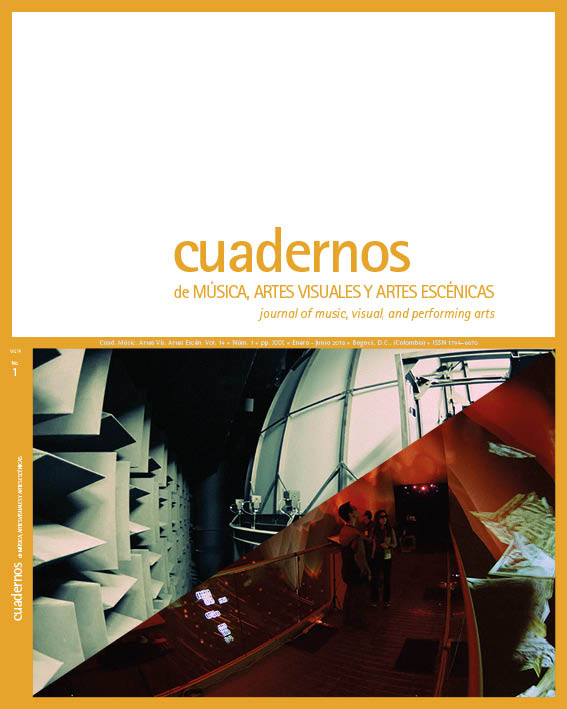Resumen
I establish a reflection about the psychoanalytic concepts of repression and death drive. Within this framework, these concepts are linked to the process of rejection, acceptance and transgression of some elements that constitute the basis of artistic creation. The relationship between transgression and acceptance of noise can be understood as a dialectical and dynamic process. On the one hand, noise can be understood as a disturbing, not desirable, suppressed and repressed event; on the other hand, can become something acceptable and desirable when incorporated as an aesthetic element. This oscillatory process of acceptance and rejection may be related to two concepts of Freudian psychoanalytic theory: repression and the death drive. These concepts may help to understand the return of what was repressed, what is to be avoided, and what is perceived as noise, connecting this “return” to the idea of remembering something that has been repressed. In an aesthetic context this remembrance binds to a dynamic motion within the artistic transformations, pointing out to two seemingly paradoxical situations: repression noise (prostration) and its recall (drive). By pursuing this parallel between noise and psychoanalysis, I intend to understand the mechanism from which an uncomfortable, noisy and sometimes destructive element becomes crucial to overcome a conservative inertia and thus set in motion a spring that propels the cultural dynamics. Although denoting a paradox, this dynamic, allows the incorporation of what is considered to be undesirable, and consists in an essential operation in the transformative processes of music.
Adorno, Horkheimer, Habermas, 259–268. São Paulo: Abril Cultural.
Adorno, Theodor. 1988 [1970]. Teoria Estética. São Paulo: Martin Fontes.
Artaud, Antonin. 1947. “La recherche de la fécalité” (performed by Roger Blin). Pour finir avec le jugement
de dieu. http://www.ubuweb.com/sound/artaud.html.
Artaud, Antonin. 1988. Antonin Artaud: Selected Writings. Edited by Susan Sontag. Berkeley: University
of California Press.
Borges, Jorge Luis. 1944 [2007]. “Funes, el memorioso”. In Ficciones, 117–128. Buenos Aires: Emecé Editores.
Campesato, Lílian (2010). “Dialética do Ruído”. In Proceedings of the XX Congresso da Associação Nacional
de Pesquisa e Pós-Graduação em Música, 1389–1393. Florianópolis.
Delouya, Daniel. 1998. “Tôpica, o negativo da depressão originária.” Revista Percurso, 21. http://www2.
uol.com.br/percurso/main/pcs21/artigo2105.htm.
Emmerson, Simon. 2001. “From Dance! to ‘Dance’: Distance and Digits.” Computer Music Journal
25(1): 13–20.
Freud, Sigmund. 2011. “O eu e o id”. In Obras completas vol. XVI. O eu e o id, “autobiografia” e outros
textos (1923–1925), 9–64. Translated by Paulo César de Souza. São Paulo: Companhia das Letras.
Freud, Sigmund, and Joseph Breuer. 1988 [1893]. “Sobre o mecanismo psíquico dos fenômenos
histéricos: comunicação preliminar”. In Obras Psicológicas Completas de Sigmund Freud. Vol. II,
37–53. Rio de Janeiro: Imago.
Freud, Sigmund. 2006 [1910]. “Cinco Lições de Psicanálise, Leonardo da Vinci e outros trabalhos”. In
Obras Psicológicas Completas de Sigmund Freud. Vol. XI, 13–51. Rio de Janeiro: Imago.
Freud, Sigmund. 1988 [1894]. “As Neuropsicoses de Defesa.” In Obras Psicológicas Completas de
Sigmund Freud. Vol. III, 53–77. Rio de Janeiro: Imago.
Freud, Sigmund. 2010 [1930]. “O Mal-Estar na Civilização”. In Obras completas. Vol. XVII, 13–122. Translated
by Paulo César de Souza. São Paulo: Companhia das Letras.
Fuks, Betty Bernardo. 2001. “Notas Sobre o Conceito de Angústia”. Estudos e Pesquisas em Psicologia
1(1). http://www.revispsi.uerj.br/v1n1/artigos/artigo1.html.
Garcia-Roza, Luiz Alfredo. 2004 [1990]. O Mal Radical em Freud. Rio de Janeiro: Jorge Zahar.
Hegarty, Paul. 2008. Noise/Music: A History. New York: Continuum.
Laplanche, Jean, and Jean-Bertrand Lefebvre Pontalis. 1988. Vocabulário da Psicanálise. São Paulo:
Martins Fontes.
Safatle, Vladimir. 2010. Políticas da Forma: Aula 5. Manuscript.
Stiegler, Bernard. 2007. Reflexões (Não) Contemporâneas. Translated by Maria Beatriz de Medeiros.
Chapecó: Argos.
Esta revista científica se encuentra registrada bajo la licencia Creative Commons Reconocimiento 4.0 Internacional. Por lo tanto, esta obra se puede reproducir, distribuir y comunicar públicamente en formato digital, siempre que se reconozca el nombre de los autores y a la Pontificia Universidad Javeriana. Se permite citar, adaptar, transformar, autoarchivar, republicar y crear a partir del material, para cualquier finalidad, siempre que se reconozca adecuadamente la autoría, se proporcione un enlace a la obra original y se indique si se han realizado cambios. La Pontificia Universidad Javeriana no retiene los derechos sobre las obras publicadas y los contenidos son responsabilidad exclusiva de los autores, quienes conservan sus derechos morales, intelectuales, de privacidad y publicidad.
El aval sobre la intervención de la obra (revisión, corrección de estilo, traducción, diagramación) y su posterior divulgación se otorga mediante una licencia de uso y no a través de una cesión de derechos, lo que representa que la revista y la Pontificia Universidad Javeriana se eximen de cualquier responsabilidad que se pueda derivar de una mala práctica ética por parte de los autores. Como consecuencia de la protección brindada por la licencia de uso, la revista puede publicar retractaciones o corregir la información ya publicada. La publicación de contenidos en esta revista no representa regalías para los contribuyentes.


